The American mastodon, Mammut americanum, is one of the very best-known prehistoric mammals. Many complete skeletons have been found throughout the North American continent, from this one-tusked male at the Royal Ontario Museum to this female and calf from the La Brea Tar Pits of California. And yet the mighty mastodon has been largely overlooked by toy companies in favour of its more famous relative, the woolly mammoth. That is, until now.
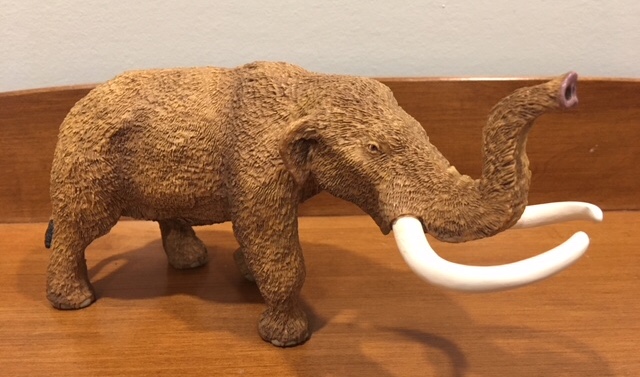
Safari Ltd released a number of fine prehistoric mammals courtesy of master sculptor Doug Watson way back in 2004, but a stipulation in the company’s contract with Carnegie prohibited any further such creations. But Safari finally severed dealings with Carnegie in 2015, and while many collectors, including myself, mourned that outcome at the time, the result has been a plethora of prehistoric mammals for the 2018 Wild Safari line! Among them is this wonderful American mastodon. At 21 cm in length and 10 cm tall at the shoulder (11.5 cm including the tip of the raised trunk), it is presently the biggest prehistoric mammal in the Wild Safari line to date, easily humbling the Amebelodon and woolly mammoth. Based on the abundant fossil remains, the average mastodon grew to the same weight as a modern elephant, but some males may have reached up to 12 tons. And a European species, M. borsoni, weighed an estimated 15 tons, making it the second largest known proboscidean!
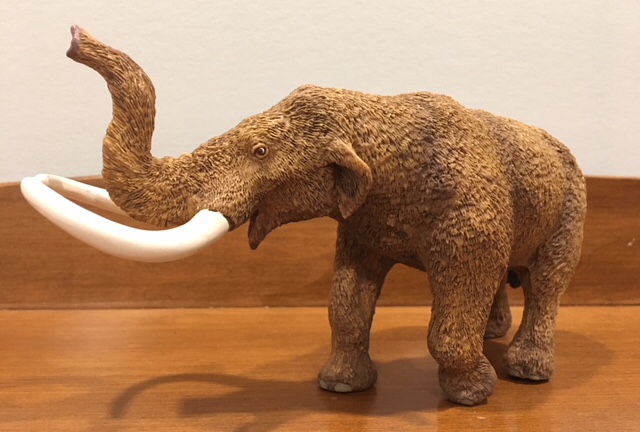
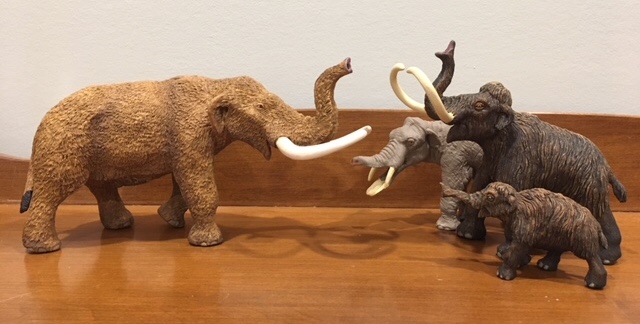
“Listen up, you mugs, I’m givin’ the orders around here now, see?”
Some people easily confuse or equate the American mastodon with the woolly mammoth due to the fact that they are both extinct proboscideans with huge tusks and shaggy fur that coexisted in the same regions. But compared to its distant relative, the mastodon had a flatter skull, lower shoulders, shorter legs, a longer body, a more muscular build, and thinner fur. Morever, its mouth boasted very distinct, cusp-shaped teeth as opposed to the flatter teeth of mammoths and modern elephants. Indeed, the word “mastodon” literally means “nipple tooth” due to the fact that the teeth reminded 18th century palaeontologists of the nipples on human breasts! Save for those teeth, all of these distinguishing characteristics are readily apparent on this figure. It is posed in a walking stance with its great head swung to the right, its mouth open, and its trunk raised high. This majestic tusker is making its presence known to all!
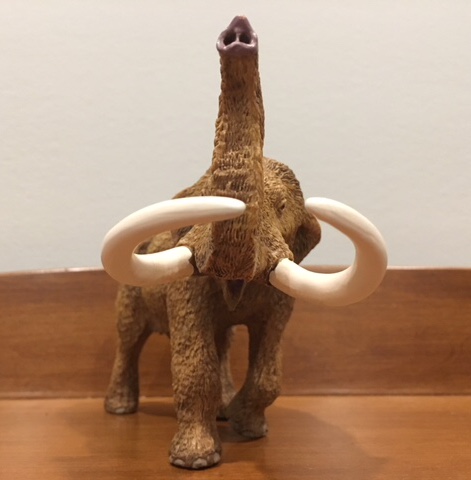
The main colour on this toy is medium brown with dark wash to give it a layered appearance. The tusks are dirty white with faint pink near the roots. The eyes are a rich brown, the mouth and the tip of the trunk are purple, the toenails are grey, and the tuft at the end of the tail is black. The shaggy fur covering the animal’s entire body has been meticulously, almost lovingly sculpted. The bulging muscles visible beneath the fur give the animal a fluid, very lifelike appearance. I don’t own any of Safari’s other 2018 prehistoric mammals just yet, but I honestly can’t imagine any of them having detail superior to this one. It’s certainly the best-sculpted prehistoric proboscidean I’ve ever seen. Hands down.
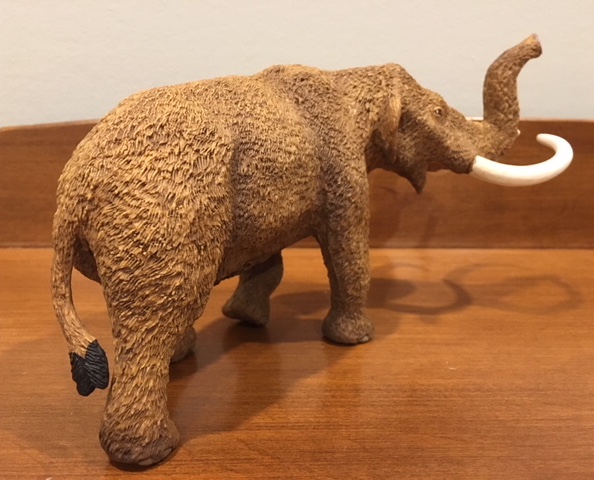
This American mastodon has it all: impressive size, scientific accuracy, and outstanding detail. And as I noted back in the intro, mastodon toys are far from legion. I definitely recommend this gem to anyone who enjoys prehistoric mammal figures, or anyone looking to start collecting them. My compliments go out to artist Doug Watson for his masterful craftsmanship. And thank you to FaunaFigures.com for this and many other figures. 🙂
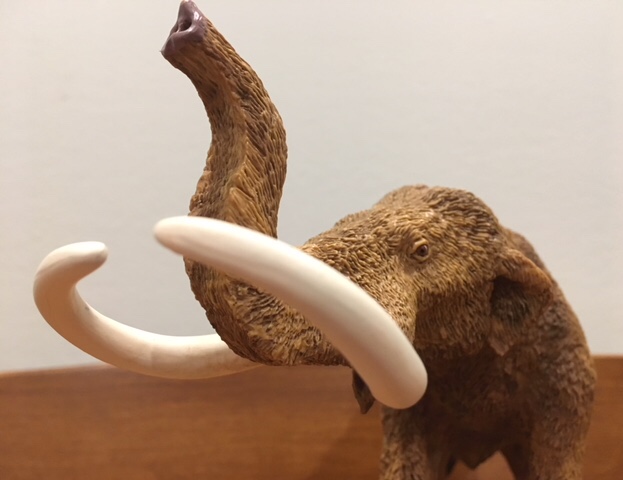
Support the Dinosaur Toy Blog by making dino-purchases through these links to Ebay and Amazon. Disclaimer: links to Ebay.com and Amazon.com on the Dinosaur Toy Blog are often affiliate links, when you make purchases through these links we may make a commission

I found a really cool vintage figure by Imperial that seems to be an American mastodon. Would anybody like me to review it? I believe it is from 1988? It is a bit old-school style but quite a good sculpt for a lesser name brand company. It even has a dusting of snow painted on its back!
This Mastodon is absolutely superb. It is packed with scientific accuracy. A true gem in every way.
Indeed. Makes me keen for the 2019 line!
Definitely getting this at some point! It kills me though that it is not in scale with the older Safari prehistoric mammals! It’s going to look weird with my mammoth and Amebelodon… 🙁
I like how massive it is. The original Prehistoric Life Safari mammals aren’t in scale with one another anyway.
From what I can tell, most of the Safari prehistoric mammals are in scale with each other (1:25 or 1:30 if you assume some are less than world record size), with the exception of the Wild Safari wooly mammoth, which is more like 1:40 or 1:45. The Carnegie wooly mammoth, Amebelodon, Megacerops, Mastodon, Daeodon, etc. are all more or less in scale with each other.
This is easily one of the best 2018 releases (out of all the brands) for me. I’m so glad to have one in my collection. Nice review too.
Way to start of 2018! Its about time we received a Mastodon! Thank you Safari and Doug Watson for this original figure. Thanks for the great review Suspsy.
Thanks! ‘‘Twas a pleasure!
On a positive note regarding the Carnegie, their old, but still superb Wooly Mammoth, also 1/30 scale, makes a terrific companion to this piece.
Sincerely, he is the figure of mastodon (mammoth americanum) that he had always wanted, both in size and paleoartistic finish.
Matriculation of honor for Doug Watson in this figure and I can assure you that I say it sincerely. A work of art! I will never regret having bought it! It has been one of my best Safari 2018 gifts!
This is the second time that I’ve read about this background to the puzzling absence of prehistoric mammals in the Safari portfolio. No doubt the inferior quality of their dinosaurian output, over against the Carnegies, can be similarly accounted for. This wouldn’t have been such a big deal if the output of Carnegie sculpts hadn’t dwindled to one to two per annum. The consumer has been the loser in this arrangement. Now that Safari is no longer “fettered to a corpse,” we are experiencing an astonishing renaissance, where supremely gifted paleo-artists such as Doug Watson can give full reign to their talents. We are blessed!
Very nice model!
“Safari Ltd released a number of fine prehistoric mammals courtesy of master sculptor Doug Watson way back in 2004, but a stipulation in the company’s contract with Carnegie prohibited any further such creations. But Safari finally severed dealings with Carnegie in 2015…”
I feel like I’ve gotten a hint of a whole backstory of politicking and intrigue that I’ve hitherto overlooked.